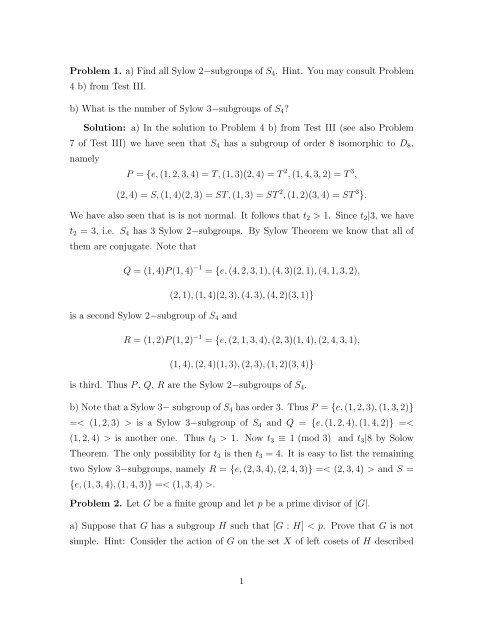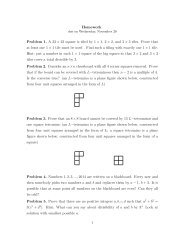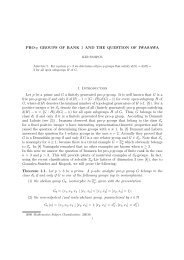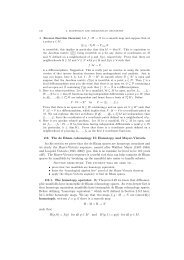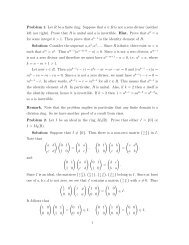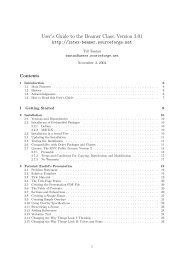Problem 1. a) Find all Sylow 2−subgroups of S 4. Hint. You may ...
Problem 1. a) Find all Sylow 2−subgroups of S 4. Hint. You may ...
Problem 1. a) Find all Sylow 2−subgroups of S 4. Hint. You may ...
You also want an ePaper? Increase the reach of your titles
YUMPU automatically turns print PDFs into web optimized ePapers that Google loves.
<strong>Problem</strong> <strong>1.</strong> a) <strong>Find</strong> <strong>all</strong> <strong>Sylow</strong> <strong>2−subgroups</strong> <strong>of</strong> S<strong>4.</strong> <strong>Hint</strong>. <strong>You</strong> <strong>may</strong> consult <strong>Problem</strong><br />
4 b) from Test III.<br />
b) What is the number <strong>of</strong> <strong>Sylow</strong> 3−subgroups <strong>of</strong> S4?<br />
Solution: a) In the solution to <strong>Problem</strong> 4 b) from Test III (see also <strong>Problem</strong><br />
7 <strong>of</strong> Test III) we have seen that S4 has a subgroup <strong>of</strong> order 8 isomorphic to D8,<br />
namely<br />
P = {e, (1, 2, 3, 4) = T, (1, 3)(2, 4) = T 2 , (1, 4, 3, 2) = T 3 ,<br />
(2, 4) = S, (1, 4)(2, 3) = ST, (1, 3) = ST 2 , (1, 2)(3, 4) = ST 3 }.<br />
We have also seen that is is not normal. It follows that t2 > <strong>1.</strong> Since t2|3, we have<br />
t2 = 3, i.e. S4 has 3 <strong>Sylow</strong> <strong>2−subgroups</strong>. By <strong>Sylow</strong> Theorem we know that <strong>all</strong> <strong>of</strong><br />
them are conjugate. Note that<br />
Q = (1, 4)P(1, 4) −1 = {e, (4, 2, 3, 1), (4, 3)(2, 1), (4, 1, 3, 2),<br />
is a second <strong>Sylow</strong> 2−subgroup <strong>of</strong> S4 and<br />
(2, 1), (1, 4)(2, 3), (4, 3), (4, 2)(3, 1)}<br />
R = (1, 2)P(1, 2) −1 = {e, (2, 1, 3, 4), (2, 3)(1, 4), (2, 4, 3, 1),<br />
(1, 4), (2, 4)(1, 3), (2, 3), (1, 2)(3, 4)}<br />
is third. Thus P, Q, R are the <strong>Sylow</strong> <strong>2−subgroups</strong> <strong>of</strong> S<strong>4.</strong><br />
b) Note that a <strong>Sylow</strong> 3− subgroup <strong>of</strong> S4 has order 3. Thus P = {e, (1, 2, 3), (1, 3, 2)}<br />
=< (1, 2, 3) > is a <strong>Sylow</strong> 3−subgroup <strong>of</strong> S4 and Q = {e, (1, 2, 4), (1, 4, 2)} =<<br />
(1, 2, 4) > is another one. Thus t3 > <strong>1.</strong> Now t3 ≡ 1 (mod 3) and t3|8 by Solow<br />
Theorem. The only possibility for t3 is then t3 = <strong>4.</strong> It is easy to list the remaining<br />
two <strong>Sylow</strong> 3−subgroups, namely R = {e, (2, 3, 4), (2, 4, 3)} =< (2, 3, 4) > and S =<br />
{e, (1, 3, 4), (1, 4, 3)} =< (1, 3, 4) >.<br />
<strong>Problem</strong> 2. Let G be a finite group and let p be a prime divisor <strong>of</strong> |G|.<br />
a) Suppose that G has a subgroup H such that [G : H] < p. Prove that G is not<br />
simple. <strong>Hint</strong>: Consider the action <strong>of</strong> G on the set X <strong>of</strong> left cosets <strong>of</strong> H described<br />
1
in <strong>Problem</strong> 2 <strong>of</strong> homework 40. Prove that the corresponding homomorphism G −→<br />
Sym(X) is not injective.<br />
b) Suppose that p is the sm<strong>all</strong>est prime divisor <strong>of</strong> |G| and that [G : H] = p. Prove<br />
that H is normal in G. <strong>Hint</strong>: Consider the homomorphism suggested in a) and<br />
prove that H is its kernel.<br />
Solution: a) As discussed in problem 2 <strong>of</strong> homework 40, the action <strong>of</strong> G on the<br />
set X <strong>of</strong> left cosets <strong>of</strong> H in G corresponds to a homomorphism ψ : G −→ Sym(X).<br />
Let m = |X| = [G : H], so m < p. Thus Sym(X) is isomorphic to the symmetric<br />
group Sm. Note that p||G| and p ∤ |Sym(X)| = m!. Thus ψ can not be injective<br />
(otherwise, the image <strong>of</strong> ψ would be a subgroup <strong>of</strong> Sym(X) <strong>of</strong> order divisible by<br />
p, which is not possible). Thus kerψ is a non-trivial normal subgroup <strong>of</strong> G. Since<br />
we have seen in <strong>Problem</strong> 2 <strong>of</strong> homework 40 that kerψ ⊆ H, kerψ is also a proper<br />
subgroup. Thus G is not simple.<br />
b) We keep the notation introduced in a), so now m = p. Let K = kerψ. By the First<br />
Isomorphism Theorem, the image <strong>of</strong> ψ is isomorphic to G/K and it is a subgroup<br />
<strong>of</strong> Sym(X), so its order divides p!. It also divides |G|, so |G/K| divides gcd(|G|,p!).<br />
Since <strong>all</strong> prime divisors <strong>of</strong> |G| are larger or equal to p, we have gcd(|G|/p, (p−1)!) = 1<br />
so gcd(|G|,p!) = p. Thus |G/K| divides p, so it is equal to p. Thus [G : K] = p =<br />
[G : H]. Since K ⊆ H, we must have H = K. Thus H is normal in G.<br />
<strong>Problem</strong> 3. Let G be a finite group and let P be a <strong>Sylow</strong> p−subgroup <strong>of</strong> G (for<br />
some prime p).<br />
a) Suppose that f : G −→ H is a surjective homomorphism. Prove that f(P) is a<br />
<strong>Sylow</strong> p−subgroup <strong>of</strong> H.<br />
b) Let N be a normal subgroup <strong>of</strong> G. Prove that P ∩ N is a <strong>Sylow</strong> p−subgroup <strong>of</strong><br />
N.<br />
Solution: a) Let |G| = p a m, p ∤ m, K = kerf and |K| = p b n, p ∤ n. Since<br />
|K|||G|, we have b ≤ a and n|m. By the First Isomorphism Theorem, H is isomor-<br />
phic to G/K, so |H| = p a−b m/n. Again by the First Isomorphism Theorem, f(P) is<br />
isomorphic to P/(P ∩K). Since P ∩K is a p−subgroup <strong>of</strong> K, |P ∩K| = p c for some<br />
c ≤ b. Thus |f(P)| = p a−c . On the other hand, p a−c = |f(P)|||H|, so a − c ≤ a − b,<br />
2
i.e. c ≥ b. Thus c = b and |f(P)| = p a−b , i.e. f(P) is a <strong>Sylow</strong> p−subgroup <strong>of</strong> H.<br />
b) Apply the solution to a) to the canonical homomorphism f : G −→ G/N, so<br />
N = kerf = K. We have seen that |P ∩ K| = p b , where |K| = p b n, p ∤ n. Thus<br />
P ∩ K = P ∩ N is a <strong>Sylow</strong> p−subgroup <strong>of</strong> N.<br />
Remark. Look also at solution to <strong>Problem</strong> 1 <strong>of</strong> Homework 37.<br />
3


